|
|
|
Sort Order |
|
|
|
Items / Page
|
|
|
|
|
|
|
| Srl | Item |
| 1 |
ID:
128993
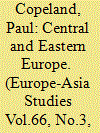

|
|
|
|
|
| Publication |
2014.
|
| Summary/Abstract |
This article analyses the influence and status of the Central and Eastern European states within an enlarged European Union. It analyses two European Union policy negotiations: the Services Directive and the European Union's Financial Crisis Rescue Plan. Central to understanding the influence of a member state within negotiations are its economic size and knowledge of the Brussels policy-making apparatus. Nevertheless, as the new member states from Central and Eastern Europe have gained experience of the European Union policy negotiation process, they remain limited in their ability to influence outcomes. Therefore it can be concluded that while knowledge during negotiations is a necessary condition for successfully influencing outcome, alone it is insufficient because economic weight is particularly pertinent to those outcomes. As a result, the status of the new member states within the European Union is best described as being that of a junior partner, despite the assumed parity of Union membership.
|
|
|
|
|
|
|
|
|
|
|
|
|
|
|
|
| 2 |
ID:
130893
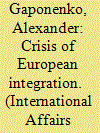

|
|
|
|
|
| Publication |
2014.
|
| Summary/Abstract |
AFTER THE USSR'S COLLAPSE, the Baltic states came under the political influence of the US and the economic influence of the European Union. This influence was used by their new geopolitical "curators" to initiate an anti-Russian line in both the foreign and domestic policies of Latvia, Lithuania and Estonia, as well as to break their economic ties with Russia. At present, the only significant economic ties that Russia still has with the Baltic countries are in the energy sector. It's the supply of natural gas through the pipeline and distribution systems with the use of the Incukalns underground storage facility. It's also the supply of Russian electricity and rail deliveries of hydrocarbons via the Ventspils and Klaipeda ports.
|
|
|
|
|
|
|
|
|
|
|
|
|
|
|
|
| 3 |
ID:
099254
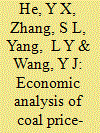

|
|
|
|
|
| Publication |
2010.
|
| Summary/Abstract |
In recent years, coal price has risen rapidly, which has also brought a sharp increase in the expenditures of thermal power plants in China. Meantime, the power production price and power retail price have not been adjusted accordingly and a large number of thermal power plants have incurred losses. The power industry is a key industry in the national economy. As such, a thorough analysis and evaluation of the economic influence of the electricity price should be conducted before electricity price adjustment is carried out. This paper analyses the influence of coal price adjustment on the electric power industry, and the influence of electricity price adjustment on the macroeconomy in China based on computable general equilibrium models. The conclusions are as follows: (1) a coal price increase causes a rise in the cost of the electric power industry, but the influence gradually descends with increase in coal price; and (2) an electricity price increase has an adverse influence on the total output, Gross Domestic Product (GDP), and the Consumer Price Index (CPI). Electricity price increases have a contractionary effect on economic development and, consequently, electricity price policy making must consequently consider all factors to minimize their adverse influence.
|
|
|
|
|
|
|
|
|
|
|
|
|
|
|
|
| 4 |
ID:
192159


|
|
|
|
|
| Summary/Abstract |
Interest and anxiety about China’s economic statecraft, or the ways in which it uses economic means to achieve foreign policy, is booming. The overriding perception is that China has sophisticated, long-term plans to enhance its power on the global stage through the use of economic strategies and tools and that it is uniquely capable of effectively implementing those plans now or in the future. Yet when it comes to actual outcomes, whether or not China has been able to achieve its foreign policy goals via economic means, the evidence is mixed at best. This article seeks to move beyond some of the shortcomings in our understanding of Chinese economic statecraft by exploring the links between perceptions, ambitions, abilities, and outcomes of Chinese foreign economic policies and behaviour. We propose an alternative to the concept of economic statecraft by introducing instead five different ‘modes of economic influence’. We suggest directions for future research focused on China’s economic influence, including its latent structural power.
|
|
|
|
|
|
|
|
|
|
|
|
|
|
|
|
| 5 |
ID:
142400
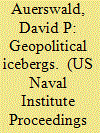

|
|
|
| 6 |
ID:
134040
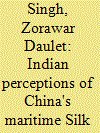

|
|
|
|
|
| Publication |
2014.
|
| Summary/Abstract |
The Maritime Silk Road (MSR) idea is part of this wider attemptby China to construct multiple lines of communication to its economicheartland in eastern China since the early 2000s. The underlying aim ofsuch a geostrategy is to also develop inner Chinese provinces and shapeChina's regional periphery by exercising economic, political and cultural Influence.
In May 2014, Xinhua unveiled maps showing China's ambitious Landand Maritime Silk Roads.3 The MSR envisions an 'economic cooperationarea' stretching from the Western Pacific to the Baltic Sea as a sort ofmaritime highway buttressed by Chinese-supported infrastructure andport facilities in states straddling maritime routes along which China'strade and natural resources flow.
|
|
|
|
|
|
|
|
|
|
|
|
|
|
|
|
| 7 |
ID:
137918
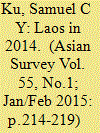

|
|
|
|
|
| Summary/Abstract |
Laos improved its economy in 2014, although its human rights record continues to receive critiques from international society. With frequent visits of Lao leaders to China and the opening of the fourth Thai-Lao Friendship Bridge, Laos deepened its relations with China in 2014, despite the emerging challenges that China faces.
|
|
|
|
|
|
|
|
|
|
|
|
|
|
|
|
| 8 |
ID:
130917
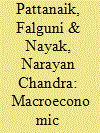

|
|
|
|
|
| Publication |
2014.
|
| Summary/Abstract |
Despite India's resurgent growth over the past years, the country seems to have failed miserably on the employment front. The employment content of economic growth-the employment intensity of growth-is on the decline. The objective of the present study is to identify the macroeconomic determinants which influence the employment intensity of growth in India. The study covers data for the period 1993-94 to 2009-10 across 15 major Indian states and applies a panel data model to find out these determinants. The results tend to suggest that labour supply, economic structure, price instability and human capital are major determining factors. Pro-employment growth in India may require measures like diversification of economic activities towards labour-intensive sectors, price stability, skill-based education and adoption of labour-intensive technology.
|
|
|
|
|
|
|
|
|
|
|
|
|
|
|
|
| 9 |
ID:
138049


|
|
|
|
|
| Summary/Abstract |
The twenty-five-year-long partnership between Russia and the West (never easy and never straightforward), which began back in the last years of Soviet perestroika, has ended. It will be probably replaced with a new structure of international cooperation much more pragmatic and devoid of illusions and exaggerated expectations nurtured by Russia rather than the West. It is wrong to expect that when the situation in Ukraine has been stabilized (it will be stabilized sooner or later) the world (or at least the part which stretches from Vladivostok in the east to Vancouver in the west) will go back to its pre-crisis state. There is no way back. The old bridges were burned while new bridges have not yet been built. The paradigm of world development geared at the prospects of long-term partnership (which, for a long time, had looked the only option) was destroyed.
|
|
|
|
|
|
|
|
|
|
|
|
|
|
|
|
| 10 |
ID:
130918


|
|
|
|
|
| Publication |
2014.
|
| Summary/Abstract |
A far-sighted food policy is essential to facilitate efficient functioning of food production and management systems, especially for a country like India where household level food security still remains elusive. In this context, reliable mechanisms for generating outlooks on key variables such as demand, supply, trade, prices, etc., of important food commodities forms an essential basis for planning. This paper explores the theoretical underpinnings as well as practical applications of the Cereal Outlook Model, a dynamic, partial-equilibrium model, developed by the authors with the specific purpose of generating future outlooks on major cereals in India. Based on this, projections as well as policy simulations on main demand and supply side variables of rice, wheat and maize were carried out for the period spanning 2011-2025. The model results indicate fast-growing trends in demand and supply of the three cereals considered. Though growth in demand would be sufficiently high due to growing per capita income, population and urbanisation; supply would keep pace owing to the emergence of new areas contributing towards incremental production. Consequently, the net trade of all three commodities would remain positive, though some signs of tapering off in net trade are expected in case of wheat and maize.
|
|
|
|
|
|
|
|
|
|
|
|
|
|
|
|
| 11 |
ID:
125642
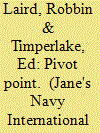

|
|
|
|
|
| Publication |
2013.
|
| Summary/Abstract |
The strategic pivot toward the Asia-Pacific region is intended to rebalance the projection and focus of US military power in the years ahead. However, it will not be without its challenges.
|
|
|
|
|
|
|
|
|
|
|
|
|
|
|
|
| 12 |
ID:
149045
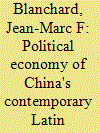

|
|
|
|
|
| Summary/Abstract |
There is a relative dearth of research on China–Latin America political economic relations, especially where Chinese outward foreign direct investment (COFDI) is concerned. In my introductory article, I aim to enrich our knowledge about how external and internal political and economic factors interact to shape Sino–Latin American links. I offer background information on Chinese investment in Latin America, identify several analytical questions that have arisen in conjunction with COFDI in Latin America, and specify some of the key findings of the other articles in this special issue. The contributors indicate that COFDI and other Sino–Latin American economic ties may not be dramatically reshaping host country foreign policies toward China, that positive political relations are not sufficient to ensure smooth economic relations or growing COFDI, and that the activities of Chinese firms in Latin America may be shaped by the host country’s institutional environment and their own operational interests rather than by any dictates from Beijing.
|
|
|
|
|
|
|
|
|
|
|
|
|
|
|
|
| 13 |
ID:
137552


|
|
|
|
|
| Summary/Abstract |
This article argues that the current ways of conceptualizing and understanding Russian warfare are flawed. To improve this, this article reviews the current ways of approaching Russian warfare from post-independence to after Ukraine. Then, we investigate Russian warfare from the four spectrums of military, informational, economic, and energy, and from political influence operations. From this, we propose the concept of Full-Spectrum Conflict that captures the use of violent and non-violent means as well as the conduct of conflict in differing degrees of intensity from peace to war and the space in between. This remedies the problem of conceptualizing, and hopefully understanding, the conduct of Russian conflict.
|
|
|
|
|
|
|
|
|
|
|
|
|
|
|
|
| 14 |
ID:
130912
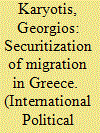

|
|
|
|
|
| Publication |
2012.
|
| Summary/Abstract |
The field of security is largely controlled by elites who, by virtue of their authority, are able to create an image of an enemy which is largely independent of the objective significance of a threat. However, a narrow focus on speech acts and discourse analysis to study such processes of securitization is inherently inadequate. This article provides a panoramic account of Greek migration politics during the 1990s. It shows that securitization can be discursive or nondiscursive, pre-mediated or subconscious, and beneficial or detrimental for securitizing actors. Elite interviews and an in-depth analysis of contextual factors help make sense of these dynamics
|
|
|
|
|
|
|
|
|
|
|
|
|
|
|
|
| 15 |
ID:
087460


|
|
|
|
|
| Publication |
2009.
|
| Summary/Abstract |
It is difficult to measure the size, influence and growth patterns of criminal organizations embedded in illegal markets. In this paper, we argue that measuring the influence of a criminal organization by its size (in number of employees, or 'members') may under- or overestimate its sphere of influence in illegal markets. Self-report survey and size of population methodologies are combined to assess the regional economic influence of a criminal organization (Hells Angels) in three illegal drug markets (the cocaine trade, the cannabis trade and the cannabis cultivation industry) in the province of Qu bec. Findings suggest that a relatively small organization by conventional standards can nonetheless achieve a large influence on criminal markets. We then analyse how factors other than violence play a role in explaining differences in achieving economic influence across criminal organizations. Finally, we suggest that turning our attention to measuring economic influence provides some insights into the duration and intensity of the violent conflicts occurring in these markets.
|
|
|
|
|
|
|
|
|
|
|
|
|
|
|
|
|
|
|
|
|